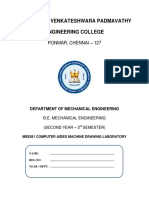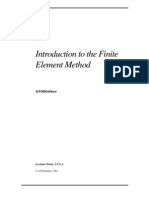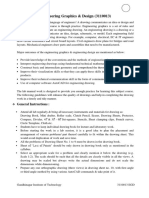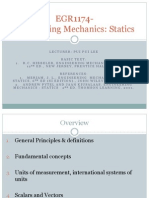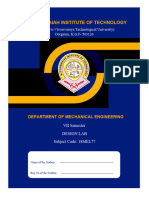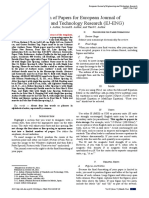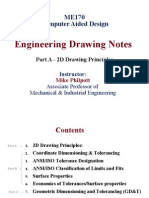Engineering Drawing Notes: ME170 Computer Aided Design
Uploaded by
mariopi32Engineering Drawing Notes: ME170 Computer Aided Design
Uploaded by
mariopi32ME170 - Engineering Drawing Notes
Page 1
ME170 Computer Aided Design
Engineering Drawing Notes
(Blueprints - 2D Detail Drafting)
Instructor: Mike Philpott Associate Professor of Mechanical & Industrial Engineering
Contents
1. 2. 3. 4.
2D Drawing Principles: Tolerances ANSI/ISO Tolerance Designation ANSI/ISO Classification of Limits and Fits Surface Properties Economics of Tolerances/Surface properties Attention to Detail
5. 6.
The engineering drawing is the specification for the component or assembly and is an important contractual document with many legal implications, every line and every comment is important.
Dr. Mike Philpott
ME170 - Engineering Drawing Notes
Page 2
Part and Assembly Drawings
Part Drawings: Detail drawings completely describe a single part with multiview orthographic projections. projections Should provide all the information necessary to economically manufacture a high quality part. Assembly Drawings: Assembly drawings are used to show the position and functional relationship of parts in an assembly, also via multiview orthographic assembly projections. Generally they have no dimensions on them. Parts are 'balloon' identified and referenced to either detail drawing numbers or catalog numbers, via a Bill of Materials (BOM)
Orthographic Views
Rear Top Left Front Bottom Rear Left Front Right Right Top Preferred 3 views form L shape
Bottom Title Block
Dr. Mike Philpott
ME170 - Engineering Drawing Notes
Page 3
The Glass Box Concept
The glass box concept theorizes that an object is suspended inside a sixsided glass cube (notice the use of hidden lines on the glass box, depicting lines that would not be visible from the given perspective).
Dr. Mike Philpott
ME170 - Engineering Drawing Notes
As the object is viewed from a specific orientation (perpendicular to one of the sides of the cube) visual rays project from the object to the projection plane. These projectors are always parallel to each other.
Page 4
The objects image is formed on the projection plane by the pierce points of the visual rays.
Dr. Mike Philpott
ME170 - Engineering Drawing Notes
The process is repeated to construct the right side view on the profile plane
Page 5
Similarly, the top view is projected to the horizontal plane
Dr. Mike Philpott
ME170 - Engineering Drawing Notes
For many three-dimensional objects, two to three orthographic views are sufficient to describe their geometry.
Page 6
The box can be unfolded to show the multiple views in a single x-y plane
Dr. Mike Philpott
ME170 - Engineering Drawing Notes
Page 7
TOP
Because the observation point is located at infinity, the integrity of feature size and location are maintained, and the views are oriented orthogonally in relationship to each other.
FRONT
RIGHT SIDE
TOP
Notice that the projectors or extension lines, are perpendicular to the folding lines of the glass box. (Fold lines and extension lines are drawn very lightly, when used, and are not part of the finished drawing.)
FRONT
RIGHT SIDE
Dr. Mike Philpott
ME170 - Engineering Drawing Notes
Dimensional Data can then be added to the drawing
Page 8
There are 3 distinct line weights to be aware of:
object lines are thick (approximately .030-.040 thick), hidden lines are a medium thickness (.015-.020), and extension, dimension, and center lines t i di i d t li are thin (.007-.010).
Dr. Mike Philpott
ME170 - Engineering Drawing Notes
Page 9
Complete the 3 view drawing (without dimensions for now). Begin by projecting all of the known information between the views.
Begin by projecting all of the known information between the views.
Dr. Mike Philpott
ME170 - Engineering Drawing Notes
Page 10
Heavy-up all of the object lines that depict visible object lines, and show surfaces that would not be visible in the specific orientation, using dashed/hidden lines.
Complete the right side view by projecting all of the relevant lines and points using a 45 degree miter line. Clean up the drawing.
Dr. Mike Philpott
ME170 - Engineering Drawing Notes
Page 11
Remove the final construction lines to see the finished drawing
Dr. Mike Philpott
ME170 - Engineering Drawing Notes
Page 12
Dr. Mike Philpott
ME170 - Engineering Drawing Notes
Page 13
Section Views
A A
Section views are used to clarify internal detail and to avoid dimensioning to hidden lines The are established by referencing a cutting plane Cutting planes depict the exact location on the part from which the section view will be projected, and should have associated arrowheads, indicating the direction from which the section view will be observed. C tti planes are constructed as Cutting l t t d an integral feature of the parent view, and cutting plane arrowheads always indicate the direction for the observers line of sight.
SECTION
A-A
Projected Section Views
A
SECTION
AA
ROTATED 30 CLOCKWISE
Dr. Mike Philpott
ME170 - Engineering Drawing Notes
Page 14
Cutting Plane
Alpha Characters A - A, B - B, C C*, etc., are used to designate the required section view. The characters are placed near the arrowheads and as a subt t e o t e e subtitle of the view. There is no standard for t e e e s o sta da d o the location of the section designators, other than near the cutting plane arrowheadsas the examples below illustrate. When the alphabet has been exhausted, use double characters AA - AA, BB - BB, CC CC*, etc. *Section Designators should NOT include the alpha characters I, O, or Q.
A Cutting plane on reference view A
Subtitle of actual view SECTION A - A
Crosshatching Section Views
Crosshatching, is a repeating graphic pattern which is applied throughout all areas of the part that would be in contact with the cutting plane Thus the hole is not plane. Thus, crosshatched. The recommended angle for the standard crosshatch pattern is 45, 30, or 60 degrees with horizontal. Similarly, crosshatch lines should be neither parallel nor perpendicular to the outline of the feature in sectionif avoidable (see the examples below).
Good Practice
Poor Practice
Poor Practice
Dr. Mike Philpott
ME170 - Engineering Drawing Notes
Page 15
Cross Hatch Standards
The general purpose cross hatch is used in most individual detail component drawings p g and in assembly applications where no confusion will result. Each of the assembled components are depicted with a different crosshatch angle to assist in part differentiation differentiation. Specific crosshatch symbols are sometimes used to represent each different material type.
Cross Hatch Symbols
Sand
Cast Iron (General Use)
White Metal (Zinc)
Steel
Magnesium, Aluminum
Titanium
Felt, Leather, & Fiber
Bronze, Brass, etc.
Concrete
Marble, Slate, Glass, etc.
Water, Liquids
Wood; Cross Grain With Grain
Dr. Mike Philpott
ME170 - Engineering Drawing Notes
Page 16
Half Sections
Half section views are the result of cutting planes being positioned on parts in such a manner that only half of the resulting view or projection is shown in section.
Half sections are generally used on objects of symmetry, individual cylindrical parts, or assemblies of parts.
Half Sections
Shown without section: Difficult to dimension without using hidden lines Internal features not as clear
Dr. Mike Philpott
ME170 - Engineering Drawing Notes
Page 17
Offset Sections
Offset sections allow us to provide greater breadth of detail with fewer section views. All of the features are aligned with the cutting plane.
D
SECTION D - D
Coordinate Dimensioning and Tolerancing
The collective process of modeling, defining and describing geometric sizes and feature relationships, and providing all of the required technical information necessary to produce and inspect the part is called dimensioning and tolerancing. tolerancing. The current National Standard for dimensioning and tolerancing in the United States is ASME Y14.5M - 1994 Y14 5M 1994.
DRAWN IN ACCORDANCE WITH ASME Y14.5M - 1994 REMOVE ALL BURRS AND SHARP EDGES ALL FILLETS AND ROUNDS R .06 UNLESS OTHERWISE SPECIFIED
Dr. Mike Philpott
ME170 - Engineering Drawing Notes
Page 18
Drawing Notes
Notes should be concise and specific. They should use appropriate technical language, and be complete and accurate in every detail. They should be authored in such a way as to have only one possible interpretation. interpretation.
General Notes
DRAWN IN ACCORDANCE WITH ASME Y14.5M - 1994 REMOVE ALL BURRS AND SHARP EDGES ALL FILLETS AND ROUNDS R .06 UNLESS OTHERWISE SPECIFIED
Local Notes
4X
8.20 M10 X 1.25 10
82 CSK
1.5 X 45 CHAM
Line Types
Object Lines
thick
Hidden Lines
thin
C Center Lines i Phantom Lines Dimension Lines Extension Lines Leader Lines Cutting Plane Line Sections - Hatching Break Lines
thin thin thin
thick
thin
thick
Dr. Mike Philpott
ME170 - Engineering Drawing Notes
Page 19
Arrowheads
Arrowheads are used as terminators on dimension lines. The points of the arrowheads on leader lines and dimension lines must make contact with the feature object line or extension lines which represent the feature being dimensioned. The standard size ratio for all arrowheads on mechanical drawings is 3:1 ( (length to width). )
200
R 8.5
Of the four different arrowhead types that are authorized by the national standard, ASME Y14.2M 1994, a filled arrowhead is the highest preference.
1st
2nd
3rd
4th
Dimension Lines and Extension Lines
Extension lines overlap dimension lines (beyond the point of the arrowheads) by a distance of roughly 2-3mm 2-
There should be a visible gap (~1.5 mm) between the object lines and the beginning of each extension line.
1.75
1.06
Dimensions should be placed outside the actual part outline. Dimensions should not be placed within the part boundaries unless greater clarity would result.
Dr. Mike Philpott
ME170 - Engineering Drawing Notes
Page 20
Placement of Linear Dimensions
Order of Preference
2.562
Arrows in / dimension in
1.250
Arrows out / dimension in
.750
Arrows in / dimension out
.500
Arrows out / dimension out
When there is not enough room between the extension lines to accommodate either the dimension value or the dimension lines they can be placed outside the extension lines as shown in the fourth example (use Flip Arrows in ProE).
Reference Dimensions
Reference Dimension Symbol (X.XXX)
EXAMPLE
2.250 1.000 (.750) .500 .500 1.250 1 250 .500 (.750)
Reference dimensions are used on drawings to provide support information only. They are values that have been derived from other dimensions and therefore should not be used for calculation, production or i inspection of parts. ti f t The use of reference dimensions on drawings should be minimized.
Dr. Mike Philpott
ME170 - Engineering Drawing Notes
Page 21
Location of Dimensions
Shorter (intermediate) dimensions are placed closest to the outline of the part, followed by dimensions of greater length. Dimensions nearest the object outline should be at least .375 inches (10 mm) away from the object, object and succeeding parallel dimension lines should be at least .250 250 inches (6 mm) apart.
4.375 1.438 1.000
.250 (6mm) Minimum Spacing
1.250
.375 (10mm) Minimum Spacing
1.875 18
.688
1.062
2.312
Dimensions should be placed outside the actual part outline
Basic Dimensioning Good Practice
4.375 1.438 1.000 1.875 .688 1.062 1.250
2.312
Extension lines should not cross dimension lines if avoidable
1.438 1.250 In-line dimensions can share arrowheads with contiguous dimensions di i
1.000 1.875 .688 1.062
2.312 4.375
BETTER
Dr. Mike Philpott
ME170 - Engineering Drawing Notes
Page 22
Diameter Dimensions
Holes and cutouts
1.375 .625 THRU
.250
.62
1.375
.250 x .62 DP
Diameter Dimensions
Shafts and Holes Whenever it is practical to do so, external diameters are dimensioned in rectangular (or longitudinal) views. Cylindrical holes, slotted holes, holes and cutouts that are irregular in shape would normally be dimensioned in views where their true geometric shape is shown.
.25 THRU
1.25 .75 2.00
Dr. Mike Philpott
ME170 - Engineering Drawing Notes
Page 23
Placement with Polar Coordinates
To dimension features on a round or axisymmetric component
18 3X 6X .562 .188
18 3.50 .875
18
18
18
18
Radial Dimensions
To indicate the size of fillets, rounds, and radii
R.312 R14.25
R.750
R.312
R.562 R 562
Dr. Mike Philpott
ME170 - Engineering Drawing Notes
Page 24
Angular Dimensions:
To indicate the size of angular details appearing as either angular or linear dimensions.
92 92
Length of Chord
35
90
or Length of Arc
103
2 x 45 or 2 x 2 CHAM
2 x 45
50
Chamfers
63 63
95
or
Alternate
Times and By Symbol: X
8X .250 THRU
.12 X 45 CHAMFER
CSK
.375 .562 X 82
The X symbol can also be used to indicate the word by. For instance, when a slot that has a given width by a specified length, or a chamfer that has equal sides (.12 X .12). When used to imply the word by, a space must precede and follow the X symbol. If the same feature is repeated on the drawing (such as 8 holes of the same diameter and in a f specified pattern), the number of times the instruction applies is called out using the symbol X.
Dr. Mike Philpott
ME170 - Engineering Drawing Notes
Page 25
Drilled Holes
Normally specified by diameter 12.5 and depth (or THRU note used).
25 45 14 THRU
90
12
12.5 32
50
2x 12 THRU
Specify reaming if accuracy/finish is important.
25
90
12
ASME/ANSI Hole Depth Symbol
Features such as blind holes and counterbores, must have a depth called out to fully describe their geometry.
Depth or Deep Symbol*
EXAMPLE
.625 .375 .625
OR
.375
* This symbol is currently not used in the ISO standard. It has been proposed.
Dr. Mike Philpott
ME170 - Engineering Drawing Notes
Page 26
ASME/ANSI Countersink Symbol
Countersink Symbol* Symbol The symbol denotes a requirement for countersunk holes used to recess flathead screws. The height of the symbol is equal to the letter height on the drawing, and the included angle is drawn at 90. Note that this symbol is not used in the ISO (international) standard.
.375 .562 X 90
EXAMPLE
* This symbol is currently not used in the ISO standard. It has been proposed.
ASME/ANSI Counterbore Symbol
Counterbore Symbol* This symbol denotes counterbored holes used to recess machine screw heads. heads
EXAMPLE
.312 .375 .562 .312 .562 .375
OR
* This symbol is currently not used in the ISO standard. It has been proposed.
Dr. Mike Philpott
ME170 - Engineering Drawing Notes
Page 27
Counterbores and Countersinks ISO Standard
12.5 32 50 2x 8.8 THRU 14 C BORE x 8.2 DP
Socket Cap Head or Machine screws
25
90
12
12.5
50 32
2x 8.8 THRU 15 CSK
Flat Head
25
90
12
Screw Threads
ISO specify metric only:M 16 x 2 M 16 x 2 - 4h - 5H
ISO metric designation Nominal N i l Diameter (mm) Class of fit of mating thread (optional) g ( p ) Thread Class of fit Pitch(mm) of this thread (optional)
American Unified Threads: 3/4 - 10 - UNC
3/4 - 10 - UNC - 2A
Nominal Diameter (inches) Threads per inch Thread Series UNC = Unified Coarse UNF = Unified Fine
Thread Type (optional) A=External B=Internal Class of fit (optional)
Note: Use standard screw sizes only
Dr. Mike Philpott
ME170 - Engineering Drawing Notes
Page 28
Threads and Screw Fastening
Always a 'Clearance Hole' (typically screw major Dia. + 10%) in at least one component in a screw fastened joint.
Example Assembly
'A'
Base
3 - M12 Hex. Screws 'A' Lid
Section 'A'-'A'
Threads and Screw Fastening (cont.)
'A'
Base Detail
3 Holes 10.3 x 25 DP M12x1.75 x 15 DP MIN EQ SP on 120 PD
Section 'A'-'A' 'A'
Dr. Mike Philpott
ME170 - Engineering Drawing Notes
Page 29
Threads and Screw Fastening (cont.)
Lid Detail
'A' 3 Holes 12.7 THRU EQ SP on 120 PD
Section 'A'-'A' 'A'
Tolerances
important to interchangeability and provision for replacement parts
It is impossible to make parts to an exact size. The tolerance, or accuracy required, will depend on the function of the part and the particular feature being dimensioned. Therefore, the range of permissible size, or tolerance, must be specified for all dimensions on a drawing, by the designer/draftsperson. Nominal Size: is the size used for general identification, not the exact size. Actual Size: is the measured dimension. A shaft of nominal diameter 10 mm may be measured to be an actual size of 9.975 mm. General Tolerances: In ISO metric general tolerances are specified in a note, usually in the metric, note title block, typically of the form: "General tolerances .25 unless otherwise stated". In English Units , the decimal place indicates the general tolerance given in the title block notes, typically: Fractions = 1/16, .X = .03, .XX = .01, .XXX = .005, .XXXX = 0.0005, Note: Fractions and this type of general tolerancing is not permissible in ISO metric standards.
Dr. Mike Philpott
ME170 - Engineering Drawing Notes
Page 30
Specific Tolerances
Specific Tolerances indicate a special situation that cannot be covered by the general tolerance. Specific tolerances are placed on the drawing with the dimension and have traditionally been expressed in a number of ways: +0.05 40 - 0.03
40.01 +0.04
40.05 39.97
Unilateral Limit Dimensions Tolerance Limits are the maximum and minimum sizes permitted by the the tolerance. All of the above methods show that the dimension has: a Lower Limit = 39 97 mm 39.97 an Upper Limit = 40.05 mm a Tolerance = 0.08 mm Manufacturing must ensure that the dimensions are kept within the limits specified. Design must not over specify as tolerances have an exponential affect on cost.
Bilateral Tolerance
Limits and Fits
1. Clearance Fits The largest permitted shaft diameter is smaller than the diameter of the smallest hole
Max. Clearance
Max. Min. Hole Hole
Max. Min. Shaft Shaft
Min. Clearance Cl
SHAFT HOLE
Dr. Mike Philpott
ME170 - Engineering Drawing Notes
Max. Interference
Page 31
2. Interference Fits The minimum permitted diameter of the shaft is larger than the maximum diameter of the hole 3. Transition Fits The di Th diameter of t f the largest allowable hole is greater than that of the smallest shaft, but the smallest hole is smaller than the
Max. Min. Hole Hole
Max. Shaft
Min. Shaft
Min. Interference
SHAFT HOLE
Interference or clearance
Max. Min. Hole Hole
Max. Shaft
Min. Shaft
SHAFT
HOLE
Standard Limits and Fits -- ANSI
Extract from Table of Clearance Fits
RC 1 Close sliding fits are intended for the accurate location of parts which must assemble without perceptible play. RC 2 Sliding fits are intended for accurate location, but with greater maximum clearance than class RC 1. Parts made to this fit move and turn easily but are not intended to run freely, and in the larger sizes may seize with small temperature changes. RC 3 Precision running fits are about the closest fits which can be expected to run freely, and are intended for precision p g journal p pressures, but are not suitable where appreciable temperature differences pp p work at slow speeds and light j are likely to be encountered. RC 4 Close running fits are intended chiefly for running fits on accurate machinery with moderate surface speeds and journal pressures, where accurate location and minimum play are desired. RC 5 Medium running fits are intended for higher running speeds, or heavy journal pressures, or both. RC 6 Basic hole system. Limits are in thousandths of an inch. Class RC 1
Limits of Clearance Nominal Size Range in Inches 0 - 0 12 0.12 Standard Limits Hole H5 +02 0.2 -0 + 0.2 -0 + 0.25 -0 + 0.3 -0 + 0.4 -0 Shaft g4 -01 0.1 - 0.25 - 0.15 - 0.3 - 0.2 - 0.35 - 0.25 - 0.45 - 0.3 - 0.55
Class RC 2
Limits of Clearance Standard Limits Hole H6 Shaft g5 -01 0.1 - 0.3 - 0.15 - 0.35 - 0.2 - 0.45 - 0.25 - 0.55 - 0.3 - 0.7
Class RC 3
Limits of Clearance Standard Limits Hole H7 +04 0.4 -0 + 0.5 -0 + 0.6 -0 + 0.7 -0 + 0.8 -0 Shaft f6 -03 0.3 - 0.55 - 0.4 - 0.7 - 0.5 - 0.9 - 0.6 - 1.0 - 0.8 - 1.3
Class RC 4
Limits of Clearance Standard Limits Hole H8 +06 0.6 -0 + 0.7 -0 + 0.9 -0 + 1.0 -0 + 1.2 -0 Shaft f7 -03 0.3 - 0.7 - 0.4 - 0.9 - 0.5 - 1.1 - 0.6 - 1.3 - 0.8 - 1.6
Class RC 5
Limits of Clearance Standard Limits Hole H8 +06 0.6 -0 + 0.7 -0 + 0.9 -0 + 1.0 -0 + 1.2 -0 Shaft e7 -06 0.6 - 1.0 - 0.8 - 1.3 - 1.0 - 1.6 - 1.2 - 1.9 - 1.6 - 2.4
Class RC 6
Limits of Clearance Standard Limits Hole H9 +10 1.0 -0 + 1.2 -0 + 1.4 -0 + 1.6 -0 + 2.0 -0 Shaft e8 -06 0.6 - 1.2 - 0.8 - 1.5 - 1.0 - 1.9 - 1.2 - 2.2 - 1.6 - 2.8
0.12 - 0.24 0.24 - 0.40 0.40 - 0.71 0.71 - 1.19 1.19 - 1.97 1.97 - 3.15
01 0.1 0.45 0.15 0.5 0.2 0.6 0.25 0.75 0.3 0.95
0 1 + 0 25 0.1 0.25 0.55 -0 0.15 + 0.3 0.65 -0 0.2 + 0.4 0.85 -0 0.25 + 0.4 0.95 -0 0.3 + 0.5 1.2 -0
03 0.3 0.95 0.4 1.12 0.5 1.5 0.6 1.7 0.8 2.1
03 0.3 1.3 0.4 1.6 0.5 2.0 0.6 2.3 0.8 2.8
0.6 06 1.6 0.8 2.0 1.0 2.5 1.2 2.9 1.6 3.6
06 0.6 2.2 0.8 2.7 1.0 3.3 1.2 3.8 1.6 4.8
Dr. Mike Philpott
ME170 - Engineering Drawing Notes
Page 32
ISO Tolerance Designation
The ISO system provides for: 21 types of holes (standard tolerances) designated by uppercase letters A, B, C, D, E....etc. and 21 types of shafts designated by the lower case letters a, b, c, d, e...etc. l tt b d t These letters define the position of the tolerance zone relative to the nominal size. To each of these types of hole or shaft are applied 16 grades of tolerance, designated by numbers IT1 to IT16 - the "Fundamental Tolerances": ITn (0.45 IT = (0 45 x 3 D +0.001 D) P 0 001 Pn where D is the mean of the range of diameters and Pn is the progression:1, 1.6, 2.5, 4.0, 6.0, 10, 16, 25......etc. which makes each tolerance grade approximately 60% of its predecessor.
For Example:
Experience has shown that the dimensional accuracy of manufactured parts is approximately proportional to the cube root of the size of the part. Example: A hole is specified as: 30 H7
The H class of holes has limits + x of . i.e. all +0 tolerances start at the nominal size and go positive by the amount designated by the IT number. IT7 for diameters ranging 30- 50 mm: Tolerance for IT7 = (0.45 x 3 40 +0.001x 40) 16 = 0.025 mm
+0.025 Written on a drawing as 30 H7 +0
Dr. Mike Philpott
ME170 - Engineering Drawing Notes
Page 33
Graphical illustration of ISO standard fits
Hole Series H hole Standard
Selection of Fits and the ISO Hole Basis system
From the above it will be realized that there are a very large number of combinations of hole deviation and tolerance with shaft deviation and tolerance. However, a given manufacturing organization will require a number of different types of fit ranging from tight drive fits to light running fits for bearings etc. Such a series of fits may be obtained using one of two standard systems:
The Shaft Basis System:
For a given nominal size a series of fits is arranged for a given nominal size using a standard shaft and varying the limits on the hole.
The Hole Basis System:
For a given nominal size the limits on the hole are kept constant, and size, constant a series of fits are obtained by only varying the limits on the shaft. The HOLE SYSTEM is commonly used because holes are more difficult to produce to a given size and are more difficult to inspect. The H series (lower limit at nominal, 0.00) is typically used and standard tooling (e.g. H7 reamers) and gauges are common for this standard.
Dr. Mike Philpott
ME170 - Engineering Drawing Notes
ISO Standard "Hole Basis"
Page 34
Clearance Fits
Type of Fit Hole Shaft
c11 Loose Running FitsSuitable for loose pulleys H11 . and the looser fastener fits where freedom of assembly is of prime importance Free Running Fit.Where accuracy is not Fit Where H9 essential, but good for large temperature variation, high running speeds, heavy journal pressures Close Running Fit. uitable for lubricated S H8 bearing, greater accuracy, accurate location, where no substantial temperature difference is encountered. Sliding Fits Suitable for precision location fits. H7 . Shafts are expensive to manufacture since the clearances are small and they are not recommended for running fits except in precision equipment where the shaft loadings are very light. Locational Clearance Fits . Provides snug fit H7 for locating stationary parts; but can be freely assembled and disassembled.
d10
f7
g6
h6
ISO Standard "Hole Basis
Transition Fits
Type of Fit Hole Shaft
k6 Locational Transition Fitsfor accurate . H7 location, a compromise between clearance and interference Push Fits Transition fits averaging little or no H7 . clearance and are recommended for location fits where a slight interferance can be tolerated for the purpose, for example, of eliminating vibration. ISO Standard "Hole Basis"
n6
Interference Fits
Type of Fit Hole Shaft
p6 s6 Press Fit Suitable as the standard press fit into H7 . ferrous, i.e. steel, cast iron etc., assemblies. H7 Drive Fit Suitable as press fits in material of low modulus of elasticity such as light alloys.
Dr. Mike Philpott
ME170 - Engineering Drawing Notes
Page 35
ISO Clearance Fits
Nominal Sizes
Over mm To mm
Tolerance
H11 0.001 mm +60 0 + 75 0 + 90 0 + 110 0 + 130 0 + 160 0 + 160 0 + 190 0 +190 0 +220 0 +220 0 +250 0 +250 0 +250 0 +290 0 +290 0 +290 0 +320 0 +320 0 +360 0 +360 0 +400 0 +400 0 c11 0.001 mm -60 -120 -70 -145 -80 -170 -95 -205 -110 110 -240 -120 -280 -130 -290 -130 -330 -150 -340 -170 -390 -180 -400 -200 -450 -210 -460 -230 -480 -240 240 -530 -260 -550 -280 -570 -300 -620 -330 -650 -360 -720 -400 -760 -440 840 -480 -850
Tolerance
H9 0.001 mm +25 0 +30 0 +36 0 +43 0 +52 52 0 +62 0 d10 0.001 mm -20 0 -30 -78 -40 -98 -50 -120 -65 65 -149 -80 -180
Tolerance
H9 0.001 mm +25 0 +30 0 +36 0 +43 0 +52 52 0 +62 0 e9 0.001 mm -14 -39 -20 -50 -25 -61 -32 -75 -40 40 -92 -50 -112
Tolerance
H8 0.001 mm +14 0 +18 0 +22 0 +27 0 +33 33 0 +39 0 f7 0.001 mm -6 -16 -10 -22 -13 -28 -16 -34 -20 20 -41 -25 -50
Tolerance
H7 0.001 mm +10 +12 0 +15 0 +18 0 +21 21 0 +25 0 g6 0.001 mm -2 -8 -4 -12 -5 -14 -6 -17 -7 7 -20 -9 -25
Tolerance
H7 0.001 mm +10 0 +12 0 +15 0 +18 0 +21 21 0 +25 0 h6 0.001 mm -6 0 -8 0 -9 0 -11 0 -13 13 0 -16 0
3 6 10 18 30 40 50 65 80 100 120 140 160 180 200 225 250 280 315 355 400 450
3 6 10 18 30 40 50 65 80 100 120 140 160 180 200 225 250 280 315 355 400 450 500
+74 0
-100 -220
+76 0
-60 -134
+46 0
-30 -60
+30 0
-12 -34
+30 0
-19 0
+87 0
-120 -260
+87 0
-72 -159
+54 0
-36 -71
+35 0
-12 -34
+35 0
-22 0
+100 0
-145 -305
+100 0
-84 -185
+63 0
-43 -83
+40 0
-14 -39
+40 0
-25 0
+115 0
-170 -355
+115 0
-100 -215
-72 0
-50 -96
+46 0
-15 -44
+46 0
-29 0
+130 0
-190 -400
+130 0
-190 -400
+130 0
-110 -240
+81 0
-96 -108
+52 0
-17 -49
+140 0
-210 -440
+140 0
-135 -265
+89 0
-62 -119
+57 0
-18 -54
+57 0
-36 0
+155 0
-230 -480
+155 0
-135 -290
+97 0
-68 -131
+63 0
-20 -60
+63 0
-40 0
Nominal Sizes
Over mm To mm
Tolerance
H7 k6 H7 n6 0.001 mm 0.001 mm 0.001 mm 0.001 mm +10 0 +12 0 +15 0 +18 0 +21 21 0 +25 0 +30 0 +35 0 +40 0 +6 +0 +9 +1 +10 +1 +12 +1 +15 15 +2 +18 +2 +21 +2 +25 +3 +28 +3 +10 0 +12 0 +15 0 +18 0 +21 21 0 25 0 +30 0 +35 0 +40 0 +10 +4 +16 +8 +19 +10 +23 +12 +23 23 +15 +33 +17 +39 +20 +45 +23 +52 +27
3 6 10
3 6 10 18 30 40 50 65 80 100 120 140 160 180 200 225 250 280 315 355 400 450 500
ISO Transition Fits
18 30 40 50 65 80 100 120 140 160 180 200 225 250 280 315 355 400 450
+46 0
+33 +4
+46 0
+60 +34
+52 0 +57 0 +63 0
-32 +40 +4 +45 +5
+52 0 +57 0 +63 0
+36 +4 +73 +37 +80 +40
Dr. Mike Philpott
ME170 - Engineering Drawing Notes
Nominal Sizes
Over mm To mm
Page 36
Tolerance
H7 0.001 mm +10 0 +12 0 +15 0 +18 0 +21 0 +25 25 0 p6 0.001 mm +12 +6 +20 +12 +24 +15 +29 +18 +35 +22 +42 42 +26
Tolerance
H7 0.001 mm +10 0 +12 0 +15 0 +18 0 +21 0 +25 25 0 +30 0 +30 0 +35 0 +35 0 +40 0 +40 0 +40 0 +46 0 +46 0 +46 0 +52 0 +52 0 +57 0 +57 0 +63 0 +63 0 s6 0.001 mm +20 +14 +27 +19 +32 +23 +39 +28 +48 +35 +59 59 +43 +72 +53 +78 +59 +93 +78 +101 +79 +117 +92 +125 +100 +133 +108 +151 +122 +159 +130 +169 +140 +198 +158 +202 +170 +226 +190 +244 +208 +272 +232 +292 +252
3 6 10 18 30 40
3 6 10 18 30 40 50 65 80 100 120 140 160 180 200 225 250 280 315 355 400 450 500
ISO Interference Fits
50 65 80 100 120 140 160 180 200 225 250 280 315 355 400 450
+30 0
+51 +32
+35 0
+59 +37
+40 0
+68 +43
+46 0
+79 +50
+52 0
+88 +56
+57 0
+98 +62
+63 0
+108 +68
Flanged Sintered Bronze Plain Bearing
Dr. Mike Philpott
ME170 - Engineering Drawing Notes
Page 37
http://www.McMasterCarr.com
Dr. Mike Philpott
ME170 - Engineering Drawing Notes
Page 38
On-line Interactive Catalogs
http://www.skf.com/portal/skf/home/products?maincatalogue=1&lang=en&newli nk=1
Tolerance Calculation - 'Worst Case Method'
for correct fit in all cases, if manufactured to specification
Allowance The minimum allowable difference between mating parts: Allowance = Smallest Hole Size - Largest Shaft Size Clearance The maximum allowable difference between mating parts: Clearance = Largest Hole Size - Smallest Shaft Size The 'Tolerance Build-up Problem' Th 'T l B ild P bl ' Where the combined dimension of several mating parts results in an unacceptable condition: generally non-functional (e.g. rotating or sliding action impaired), or parts will not assemble, or aesthetically unacceptable (e.g. inconsistent gaps around car doors)
'Shaft in hole' Terminology Hole Shaft
Dr. Mike Philpott
ME170 - Engineering Drawing Notes
Worst Case Tolerancing
B
Page 39
Shaft in Hole Example
1. Allowance = Smallest Hole Size (A) Largest Shaft Size 2. Clearance = Largest Hole Size (A) Smallest Shaft Size A
+ 0.125 If dimension with tolerance is 10 - 0 125 0.125 Lid on Box Example Largest feature size = 10.125 Smallest feature size = 9.875
Tolerance Calculation - Tensioner Assy. Example
76 +.25 A +.16 +.15 B76 +0
Axial Clearance Axial Clearance by Design must be design must 25 >0 01 be25 <0.25 <0.25 but >0.01
=> 0.01 but =< 0.25
Worst Case Tolerancing:
1. Allowance = Smallest Hole Size (76.16) Largest Shaft Size (76.15) = 0.01 2. Clearance = Largest Hole Size (76.25) Smallest Shaft Size (76.00) = 0.25
Dr. Mike Philpott
ME170 - Engineering Drawing Notes
Page 40
Surface Properties Texture and Hardness
Surface Finish
Basic Surface Texture Symbol
0.4
With Roughness Value (Typically (T i ll Ra m or ) )
Material Removal by Machining
With Machining Allowance
Hardness
Harden = HDN - may see symbol Heat Treat = H/T Rockwell = HRC, HRA etc or Ra or Rc , Brinell = BNL
0.4
HDN to 65 HRC 0.125 DP
Comparative Roughness Values
Roughness Ra
25 m (1000 ) 12.5 m (500) 6.3 m (250) 3.2 m (125) 1.6 m (63) 0.8 m (32) 0.4 m (16) 0.2 m (8) 0.1 m (4)
Typical Processes
Flame Cutting Sawing, sand casting, forging, shaping, planing Rough machining, milling, rough turning, drilling, and die casting Machining, turning, milling, die and investment casting, injection molding, and stamping Grinding, fine turning & milling, reaming, honing, injection molding, stamping, investment casting Diamond Turning, Grinding, lapping, honing Lapping, honing, polishing Superfinishing, polishing, lapping
Dr. Mike Philpott
ME170 - Engineering Drawing Notes
Page 41
Some Common Steel, Hardness and Surface Finish Specs.
Common Steel Specs: (10xx series: xx = % carbon) Mild steel (low carbon = up to 30 %): Low cost general purpose applications, typ. hardening not required
Common Types 1020 1040, 1040
Medium Carbon (up to 60%): requiring higher strength; e.g. gears, 1060 axles, con-rods etc. High Carbon (> 60%): High wear, high strength; e.g. cutting tools, springs etc. Ground Bearing Shaft Examples: General Purpose 1060: Surface HDN to 55 HRC 0.125 mm deep min.; 0.4 m ( ) p (16 ) 303 Stainless: (natural surface hardness 5 HRC ); 0.4m (16 ) Better Finish, Longer Life 1020: Case HDN to 65 HRC 0.25 mm deep min.; 0.2m (8 ) 440 Stainless: (natural circa 15 HRC); 0.2m (8 )
1080
Specifying Welds on Drawings
Weld all Around Weld on other side
30-50
Pitch Pit h Length Weld on arrow side
Width of weld
20
6
10
20
= Weld 6mm fillet weld this side only
20-10
= Weld 6mm fillet weld both sides
Dr. Mike Philpott
You might also like
- Machine Drawing With CAD - Ning (PDFDrive)No ratings yetMachine Drawing With CAD - Ning (PDFDrive)227 pages
- 【Haug-1984】Computer Aided Analysis and Optimization of Mechanical System Dynamics PDFNo ratings yet【Haug-1984】Computer Aided Analysis and Optimization of Mechanical System Dynamics PDF718 pages
- Autocad Certified User Study Guide: AutodeskNo ratings yetAutocad Certified User Study Guide: Autodesk27 pages
- Aerodynamic Analysis of Motion of Two Vehicles and Their Influence On Drag Coefficient.No ratings yetAerodynamic Analysis of Motion of Two Vehicles and Their Influence On Drag Coefficient.3 pages
- Engineering Drawing Book 2022 2023 1st Term 2 1 80 1 30No ratings yetEngineering Drawing Book 2022 2023 1st Term 2 1 80 1 3030 pages
- Ansys Manual Final Year Anna UniversityNo ratings yetAnsys Manual Final Year Anna University32 pages
- Dynamics Unit - 3 Relative Motion With SolutionsNo ratings yetDynamics Unit - 3 Relative Motion With Solutions12 pages
- Course Outline DBM 1033 Mathematical Computing100% (1)Course Outline DBM 1033 Mathematical Computing2 pages
- Introduction To The Finite Element Method: G.P.NikishkovNo ratings yetIntroduction To The Finite Element Method: G.P.Nikishkov32 pages
- SolidWorks Simulation - Avoiding SingularitiesNo ratings yetSolidWorks Simulation - Avoiding Singularities6 pages
- Machine Drawing-I: (Department of Mechanical Engineering)No ratings yetMachine Drawing-I: (Department of Mechanical Engineering)12 pages
- Department of Industrial Engineering: Thapathali Campus, KathmanduNo ratings yetDepartment of Industrial Engineering: Thapathali Campus, Kathmandu33 pages
- Week 4b, Geometric Construction (Polygons)No ratings yetWeek 4b, Geometric Construction (Polygons)4 pages
- Solving The Problem (By Hand) : 1. Drawing The Project NetworkNo ratings yetSolving The Problem (By Hand) : 1. Drawing The Project Network3 pages
- Computer-Aided Kinematics and Dynamics of MechanicNo ratings yetComputer-Aided Kinematics and Dynamics of Mechanic14 pages
- Machine Design: Static Failure Theories: Dr. Himanshu Chaudhary Associate Professor Dept. of Mech. Eng. MNIT JaipurNo ratings yetMachine Design: Static Failure Theories: Dr. Himanshu Chaudhary Associate Professor Dept. of Mech. Eng. MNIT Jaipur36 pages
- Unit III Geometrical Modelling Intro and Curve RepresentationNo ratings yetUnit III Geometrical Modelling Intro and Curve Representation40 pages
- Preparation of Papers For European Journal of Engineering and Technology Research (EJ-ENG)No ratings yetPreparation of Papers For European Journal of Engineering and Technology Research (EJ-ENG)4 pages
- Engineering Drawings: Computer Aided Design100% (1)Engineering Drawings: Computer Aided Design81 pages
- Engineering Drawing: Unlocking Visual Perception in Engineering DrawingFrom EverandEngineering Drawing: Unlocking Visual Perception in Engineering DrawingNo ratings yet
- (EN-423) RENEWABLE Energy Resources: Lecture 12 - Geothermal Energy (Geothermal Systems)No ratings yet(EN-423) RENEWABLE Energy Resources: Lecture 12 - Geothermal Energy (Geothermal Systems)32 pages
- Chapter 6 Functions: For Educational Purpose Only. Not To Be Circulated Without This BannerNo ratings yetChapter 6 Functions: For Educational Purpose Only. Not To Be Circulated Without This Banner132 pages
- 1U Switching Power Supplies: InstallationNo ratings yet1U Switching Power Supplies: Installation2 pages
- Bidirectional power flow in an electric vehicle using predictive control algorithm including sneak circuit analysisNo ratings yetBidirectional power flow in an electric vehicle using predictive control algorithm including sneak circuit analysis12 pages
- Seismic Performance of Damped-Outrigger System Incorporating Buckling-Restrained BracesNo ratings yetSeismic Performance of Damped-Outrigger System Incorporating Buckling-Restrained Braces12 pages
- Typical Joint Detailing of Steel Hollow SectionsNo ratings yetTypical Joint Detailing of Steel Hollow Sections7 pages
- Rajasthan Board Class 12 Physics Ss 40 1 2018No ratings yetRajasthan Board Class 12 Physics Ss 40 1 20188 pages
- Time:3 Hrs Class: IX M.M: 80: Salsabeel Central School TERM EXAMINATION 2018-2019 MathematicsNo ratings yetTime:3 Hrs Class: IX M.M: 80: Salsabeel Central School TERM EXAMINATION 2018-2019 Mathematics3 pages
- Effective Width of Slab Calculation as per IRC:22-2015No ratings yetEffective Width of Slab Calculation as per IRC:22-20152 pages
- Brochure Cleaning Emeia Product CatalogNo ratings yetBrochure Cleaning Emeia Product Catalog40 pages
- Dimensionless Analysis of Swelling of Hydrophilic Glassy Polymers With Subsequent Drug Release From Relaxing StructuresNo ratings yetDimensionless Analysis of Swelling of Hydrophilic Glassy Polymers With Subsequent Drug Release From Relaxing Structures12 pages
- Density, Relative Density and API Gravity: According To IP559 and ASTM D7777No ratings yetDensity, Relative Density and API Gravity: According To IP559 and ASTM D77771 page
- Handwritten Javanese Script Recognition Method Based 12-Layers Deep Convolutional Neural Network and Data AugmentationNo ratings yetHandwritten Javanese Script Recognition Method Based 12-Layers Deep Convolutional Neural Network and Data Augmentation11 pages
- A Collection of High School Vector ProblemsNo ratings yetA Collection of High School Vector Problems2 pages
- 【Haug-1984】Computer Aided Analysis and Optimization of Mechanical System Dynamics PDF【Haug-1984】Computer Aided Analysis and Optimization of Mechanical System Dynamics PDF
- Aerodynamic Analysis of Motion of Two Vehicles and Their Influence On Drag Coefficient.Aerodynamic Analysis of Motion of Two Vehicles and Their Influence On Drag Coefficient.
- Engineering Drawing Book 2022 2023 1st Term 2 1 80 1 30Engineering Drawing Book 2022 2023 1st Term 2 1 80 1 30
- Introduction To The Finite Element Method: G.P.NikishkovIntroduction To The Finite Element Method: G.P.Nikishkov
- Machine Drawing-I: (Department of Mechanical Engineering)Machine Drawing-I: (Department of Mechanical Engineering)
- Department of Industrial Engineering: Thapathali Campus, KathmanduDepartment of Industrial Engineering: Thapathali Campus, Kathmandu
- Solving The Problem (By Hand) : 1. Drawing The Project NetworkSolving The Problem (By Hand) : 1. Drawing The Project Network
- Computer-Aided Kinematics and Dynamics of MechanicComputer-Aided Kinematics and Dynamics of Mechanic
- Machine Design: Static Failure Theories: Dr. Himanshu Chaudhary Associate Professor Dept. of Mech. Eng. MNIT JaipurMachine Design: Static Failure Theories: Dr. Himanshu Chaudhary Associate Professor Dept. of Mech. Eng. MNIT Jaipur
- Unit III Geometrical Modelling Intro and Curve RepresentationUnit III Geometrical Modelling Intro and Curve Representation
- Preparation of Papers For European Journal of Engineering and Technology Research (EJ-ENG)Preparation of Papers For European Journal of Engineering and Technology Research (EJ-ENG)
- Engineering Drawing: Unlocking Visual Perception in Engineering DrawingFrom EverandEngineering Drawing: Unlocking Visual Perception in Engineering Drawing
- (EN-423) RENEWABLE Energy Resources: Lecture 12 - Geothermal Energy (Geothermal Systems)(EN-423) RENEWABLE Energy Resources: Lecture 12 - Geothermal Energy (Geothermal Systems)
- Chapter 6 Functions: For Educational Purpose Only. Not To Be Circulated Without This BannerChapter 6 Functions: For Educational Purpose Only. Not To Be Circulated Without This Banner
- Bidirectional power flow in an electric vehicle using predictive control algorithm including sneak circuit analysisBidirectional power flow in an electric vehicle using predictive control algorithm including sneak circuit analysis
- Seismic Performance of Damped-Outrigger System Incorporating Buckling-Restrained BracesSeismic Performance of Damped-Outrigger System Incorporating Buckling-Restrained Braces
- Time:3 Hrs Class: IX M.M: 80: Salsabeel Central School TERM EXAMINATION 2018-2019 MathematicsTime:3 Hrs Class: IX M.M: 80: Salsabeel Central School TERM EXAMINATION 2018-2019 Mathematics
- Effective Width of Slab Calculation as per IRC:22-2015Effective Width of Slab Calculation as per IRC:22-2015
- Dimensionless Analysis of Swelling of Hydrophilic Glassy Polymers With Subsequent Drug Release From Relaxing StructuresDimensionless Analysis of Swelling of Hydrophilic Glassy Polymers With Subsequent Drug Release From Relaxing Structures
- Density, Relative Density and API Gravity: According To IP559 and ASTM D7777Density, Relative Density and API Gravity: According To IP559 and ASTM D7777
- Handwritten Javanese Script Recognition Method Based 12-Layers Deep Convolutional Neural Network and Data AugmentationHandwritten Javanese Script Recognition Method Based 12-Layers Deep Convolutional Neural Network and Data Augmentation








